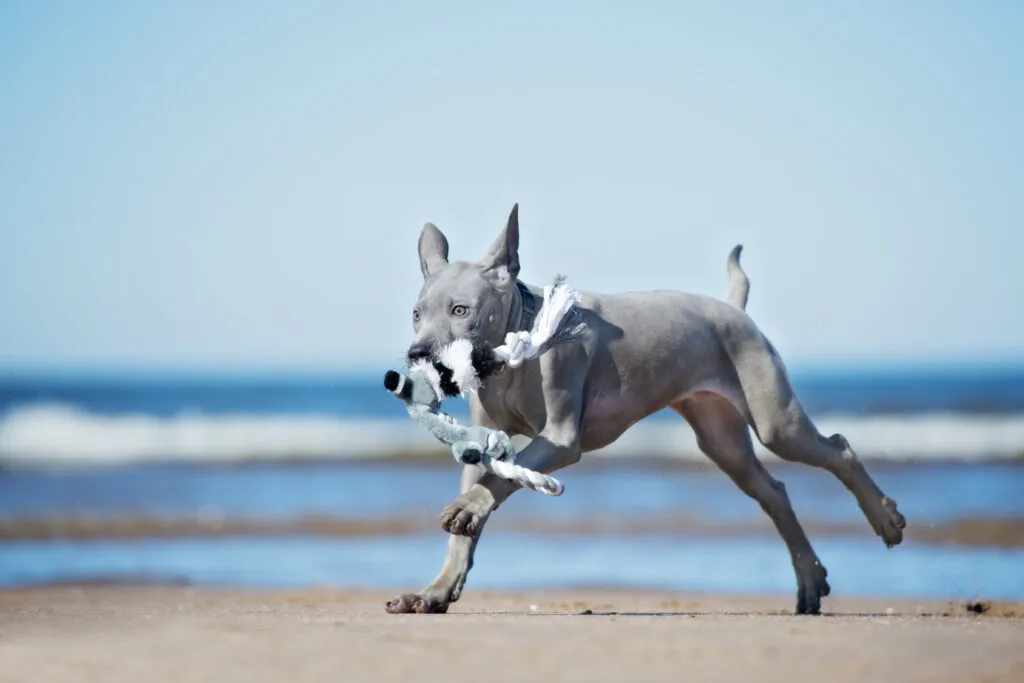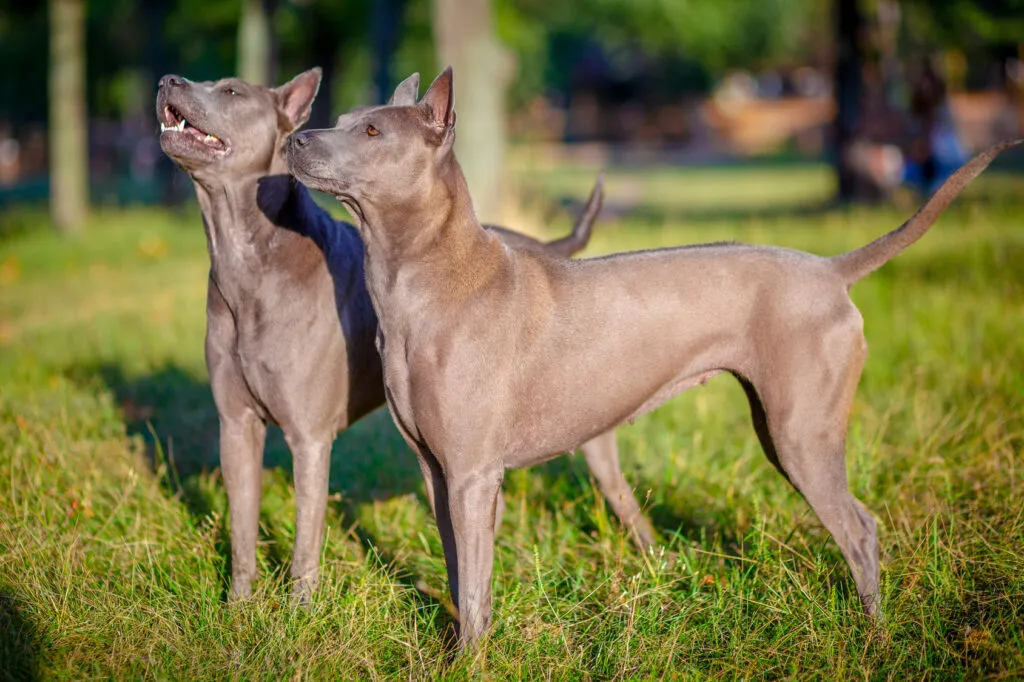Medium Size Poodle
The Thai Ridgeback, originally a hunting dog from Thailand, requires clear leadership and is a companion best suited for experienced dog aficionados.

© Kseniya / stock.adobe.com
A Thai Ridgeback should only be given to experienced owners.
The Thai Ridgeback boasts an athletic build. Its forehead has slight wrinkles, the triangular ears lean slightly forward, and its eyes are almond-shaped.
Its smooth, short fur can be red, black, blue, or fawn-coloured, with the distinctive “ridge” on its back, which gives the dog its name. The hairs grow in the opposite direction along the spine, forming a visible and palpable ridge. This ridge can vary in shape but should be symmetrical.
The Thai Ridgeback is a medium-sized dog. Females have a withers height between 51cm to 56cm, while males typically range between 56cm to 61cm.
Males can weigh up to 34kg. Females weigh a max. of 25kg.
 © otsphoto / stock.adobe.com
© otsphoto / stock.adobe.com
The Thai Ridgeback is a lively, alert dog that needs a lot of activity. As an independent hunter, it tends to remain self-reliant and usually does not form a close bond with a single person.
However, it is friendly and even affectionate within its human pack, its family. At home, it shows its calm side, while outdoors, it can really rev up.
It is reserved towards strangers but not aggressive. The Thai Ridgeback is characterized by courage and sensitivity, making it an interesting character for many dog enthusiasts.
Clever and teachable, the Thai Ridgeback could be a good candidate for easy training – if it weren’t for its large hunting drive! In case of doubt, this independently-minded dog will choose hunting over “good behaviour” if prey is in sight.
Learn more: Anti-Hunt Training for Dogs in Five Steps
It requires strong leadership from an experienced dog owner – not a breed for beginners.
“Strong leadership” does not mean training with pressure. This approach is counterproductive for these sensitive ancient dogs. Positive motivation, on the other hand, leads to quick learning progress in this smart breed.
Take your puppy to puppy play sessions and the dog school of a local dog club. This serves not only training but also positively impacts the Thai Ridgeback’s social behaviour.
This is important as the original dog can sometimes have communication issues with its peers. Various encounters from an early age strengthen the Thai Ridgeback’s social skills and lead to relaxed dog encounters later in life.
The Thai Ridgeback has a high energy level and loves to stay active.
As it is still very much an original hunting dog, it is not readily recommended as a family dog. It requires experienced owners who can train it consistently and provide enough exercise. It goes without saying that the Thai Ridgeback is not a dog for couch potatoes!
This nature boy does not enjoy city life. Not only does it shy away from the loud and hectic city life, it could be conditioned to it, but comfort is another matter. Ideally, a home in a green area with a fenced yard is perfect for the Thai to frolic.
Beware: The athletic dog can jump high and needs a very tall fence to prevent it from escaping to pursue its hunting passion. They can jump up to two metres.
The Thai can get along with children, but children and dogs should always be supervised. Small children, with their unpredictable movements and high volume, can irritate the dog. It’s wise to give the dog a retreat space if it feels pressured.
The Thai Ridgeback is a listed dog, meaning ownership of this breed is prohibited in some areas. Be sure to check if the Thai Ridgeback is on breed lists in your region. For example, they are not allowed in the canton of Geneva in Switzerland.
It’s rarely possible for a Thai Ridgeback to roam leash-free – its hunting drive is too strong, resulting in it chasing hares or the neighbour’s cat. Some of these dogs are also talented escape artists from harnesses. Ensure you buy a secure and well-fitted dog harness.
With this limitation, the Thai Ridgeback is a keen sports enthusiast for many activities: Explore together what brings you both delight: Dog Dancing, Agility, or Dog Frisbee can bring big fun to this jumper.
Tracking work or Mantrailing is also a good activity for this sniffing genius. Don’t be discouraged by a slow start – this dog often needs time to focus on a task. The key is for the Thai Ridgeback to have fun. Then it will engage in the chosen dog sport.
Alongside all sports, long walks or running together – with a fully grown dog and appropriate training – are essential for a well-exercised Ridgeback.
The short fur with the ridge requires easy care: Weekly massages with a grooming glove or soft brush usually suffice to remove excess hair. Dried dirt can often be brushed out easily, making bathing rarely necessary.
However, it’s important to get the dog used to bathing with a mild dog shampoo from puppyhood and repeat this care routine every few months.
By the way: Those keeping multiple Thai Ridgebacks may observe that these dogs groom each other like cats.
Check the claws every few weeks and clip them with a nail cutter for dogs if needed. Also, look into the ears occasionally to see if an ear cleaner for dogs is needed.
Healthy and happy – more tips on dog care:
The Thai Ridgeback, like any dog, needs dog food with a high meat content.
Tip: Ensure meat is the main ingredient of the food.
Feed your puppy the food it was used to from the breeder when it arrives. Transitioning to new food takes time, so your new family member isn’t overwhelmed by too many changes at once.
While puppies can have three to four meals a day, an adult Thai Ridgeback requires two meals, followed by a digestion rest. Manufacturer recommendations for daily amounts are just guidelines – keep an eye on your Ridgeback’s waistline. A special light food is usually not necessary.
Also, account for dog treats in the daily amount and do not exceed this, as extra reward bites can quickly add many calories. Stick to healthy products, like dental care treats or natural dog chews.
Dried chews like beef ears satisfy chewing needs and are a popular occasional supplementary snack. Of course, your dog should always have access to fresh water to quench its thirst.
Except for a few exceptions, this robust breed is hardly prone to hereditary diseases. A reputable breeder will provide you with examinations of the parent animals for healthy hips, as Thai Ridgebacks can be prone to hip dysplasia (HD). You should discuss with the breeder the common breed issue of Dermoid Sinus (DS) and preventive measures.
DS is a cystic anomaly that experienced breeders can feel; it can be and should be surgically removed at a young age. A successful surgery allows the dog to lead a symptom-free life. If not detected, it can lead to life-threatening infections. Affected animals should be excluded from breeding but can be sold as pets after surgery.
With good care and regular health checks, the Thai Ridgeback has a life expectancy of 12 to 13 years.
 © lobodaphoto / stock.adobe.com
© lobodaphoto / stock.adobe.com
The breed is not widespread but has a solid following in Europe. With some research, travel, and patience, you can typically find your desired puppy within Europe.
Even if it takes longer: Visit the Thai Ridgeback breeder at home to meet the parent dogs and familiarise yourself with the dog’s surroundings. It’s also a good opportunity to discuss the breed’s requirements with the breeder.
Learn more: Important Questions for the Dog Breeder
A responsible breeder is the foundation for a healthy dog. Thoroughly research to find a credible breeder and steer clear of “mass breeders” unaffiliated with any club. These breeders often skimp on health precautions and fail to invest time and knowledge into critical imprinting and socialisation phases.
When it arrives, your puppy will be at least eight weeks old, dewormed multiple times, and vaccinated. Ensure you keep up with booster vaccinations.
Learn more: The most important vaccinations for your dog
For breeders outside your country, consider the specific requirements for adopting puppies from abroad. Only buy a puppy from breeders providing pedigree certificates under the FCI’s auspices.
If you are looking for an adult Thai Ridgeback, consider also looking at mixed breeds or Rhodesian Ridgebacks in shelters. Purebred Thai Ridgebacks rarely seek new homes in Europe.
If you search specifically for Thai Ridgebacks, you might find them online. Some countries have Facebook groups dedicated to Thai Ridgeback rescue. As the Thai Ridgeback is a dog for connoisseurs, learning as much as possible about its background is crucial before deciding if it aligns with your experience and lifestyle.
As the name implies, the Thai Ridgeback originates in Thailand, specifically eastern Thailand. Its ancestors are pariah dogs, animals that have lived independently alongside humans for centuries.
In Thailand, the ancestors of the Thai Ridgeback were traditionally used as hunting and guard dogs. Documented over 350 years ago, the breed, originating from the Chanthaburi and Rayong provinces, gradually spread and reached Bangkok, the birthplace of its professional breeding.
The Thai Ridgeback and the Rhodesian Ridgeback are the only FCI-recognised breeds with a “ridge”. Any direct connection between the two breeds has yet to be proven.
Fans of the Bearded Collie agree that those who aren't familiar with this dog breed simply have to get acquainted with it. And those who have experienced how a Bearded Collie bolts across meadows with its flowing fur, how it rolls around full of energy and joy and how it attentively and observantly takes into account its owners wishes become simply addicted to this original dog breed and its unique charm.
The Goldendoodle isn't a breed, but a pairing between Golden Retrievers and Medium or Standard Poodles. Marketed as a low-maintenance dog for allergy sufferers, this hybrid is enjoying increasing popularity amongst dog lovers, similar to the Labradoodle.